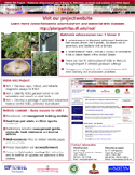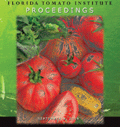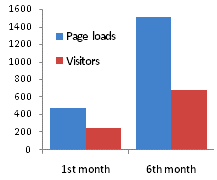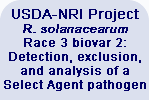| USDA-NRI Education Program | |||
| Accomplishments Develop a package of optimized education and management training modules that will educate stakeholders to control this pathogen, primarily by exclusion. (read the project summary for more details) |
|
| This page contains files in PDF format. To read these files you must have Adobe Reader installed on your computer (free). | |
| Educational materials | Program delivery | Program Evaluation |
| Development of educational materials |
| The overall aim of our educational program is to ensure that key practitioners and industry professionals are familiar with the most current and effective tools for detection and management of this pathogen. Four educational modules were developed based on input from the co-investigators of the project and on the current literature. Each module was reviewed for content and instructional design to ensure that all members of the team have a common knowledge base, and that our presentations will represent an expert consensus. Modules were optimized to serve diverse target audiences (diagnosticians, state specialists, researchers, graduate students, county faculty, consultants, industry representative, state inspectors, APHIS personnel, producers, and master gardeners), including definitions for technical terms. Modules content will constantly be revised following input from literature, output from our research program, and interaction with our target audience. In addition to the fundamental biology of the pathogen, educational modules include description and photos of symptoms and signs of diseases, information on disease cycles and epidemiology, tools currently used for diagnosis and identification of the pathogen, and management strategies. |
| |
|||||||||||||||||||||||||
| Delivery of educational materials |
|||||||||||||||||||||||||
| Ralstonia solanacearum / Bacterial Wilt - Brown Rot dedicated Website Online since September 12, 2008. This Ralstonia solanacearum Bacterial Wilt and Brown Rot Website was developped to continuously educate, communicate and connect with our target audiences. All our educational modules and research accomplishments are freely available through this web site. Additionally, new alerts from off-shore literature and agencies, and from APHIS will be posted and/or linked to this web page. On-line surveys, ring-testing procedures, and other assessment tools (see below) will be implemented through this website. The long-term sustainability of this website will be supported by NPDN and University of Florida/IFAS Extension. Website announcement. To reach our target audiences, our website URL was initially delivered through nationaly widespread mailing lists: - The UF/IFAS pest alert. 09/19/08 - Multi-state Web site on Ralstonia solanacearum (brown rot, bacterial wilt) now online. 10/31/08 - National Plant Diagnostic Network newsletter - October 2008 issue. - The NPDN First Detectors Newsletter of October, 2008. Vol. 5, #10. - All mailing lists used for base line/initial survey delivery (see the Evaluation of program Effectiveness section below). To increase our website target audience, a website announcement poster can be downloaded from this website and is routinely delivered to meeting and conferences attendees (see download counts below). This poster describes major aims of the project, URL address and main content of our website. It has been distributed to a diverse audience at the: Website update notification. A Ralstonia-L mailing list was created to inform all subscribers on updates and additions to the website. This mailing list allows real-time delivery of new educational materials, regulatory information, new pest alerts and documents. Website evaluation. See the Evaluation of program Effectiveness section below. |
|||||||||||||||||||||||||
|
On-line articles
Email notifications for these articles were delivered through our Ralstonia mailing list (see below), the UF/IFAS pest alert of
01/08/09, the APS News Capsule No. 260 of 01/08/09, and the APS News Capsule No. 266 of 04/02/09 for APS members. |
|||||||||||||||||||||||||
| Participation to meetings and conferences This effort will establish channels with end users for dissemination of the developed modules on R. solanacearum race 3 biovar 2, brown rot of potato, Southern wilt of geranium, and bacterial wilt of tomato, depending on each target audience. Meetings attended so far:
|
|||||||||||||||||||||||||
| Organisation of outreach workshops An hands-on workshop on recent DNA-based detection methods for Ralstonia solanacearum is currently being organized at the 2010 APS annual meeting. Visit the APS website for more information. |
|||||||||||||||||||||||||
| |
||||||||||||
| Evaluation of program effectiveness |
||||||||||||
The educational component of this project emphasizes participation of the end users (target audiences as described previously) to develop a nationwide prevention and detection network to successfully exclude R. solanacearum race 3 biovar 2. |
||||||||||||
Base line/initial survey The objective of this survey was to determine the initial state of knowledge on R. solanacearum race 3 biovar 2 in our target audiences and to identify the diagnostic methods currently used or known in the U.S. The survey consisted of two questionnaires customized for each of the following target group including:
The survey was developed using the survey creator program from FreeOnlineSurveys.com and the recommendations from Penn State to produce quantifiable outcomes. Prior to delivery, the survey was submitted to the Institutional Review Board of the University of Florida. Click here to see letter of approval. Survey delivery. Iinvitations to the survey were delivered nationwide using mailing lists or diverse contacts to reach the following: - Diagnosticians, using the NPDN First Detectors Newsletter of March, 2008. Vol. 5, #3 - APHIS regulators (via our collaborators). - Academics, students and university staff personnel, using University of Florida, Georgia, Hawaii, and Wisconsin Plant Pathology Departments mailing lists (via our project collaborators). - Southern and Eastern Plant Board Members (via their secretaries). - Members of the potato, tomato, and geranium industry (via our project collaborators). - Florida county agents (via our project collaborators). Survey was accessible from March 24 to October 24, 2008. Check back for survey results. |
||||||||||||
Website evaluation
|
||||||||||||
On-line articles impact
|
||||||||||||
| Click here to see project timeline. |







